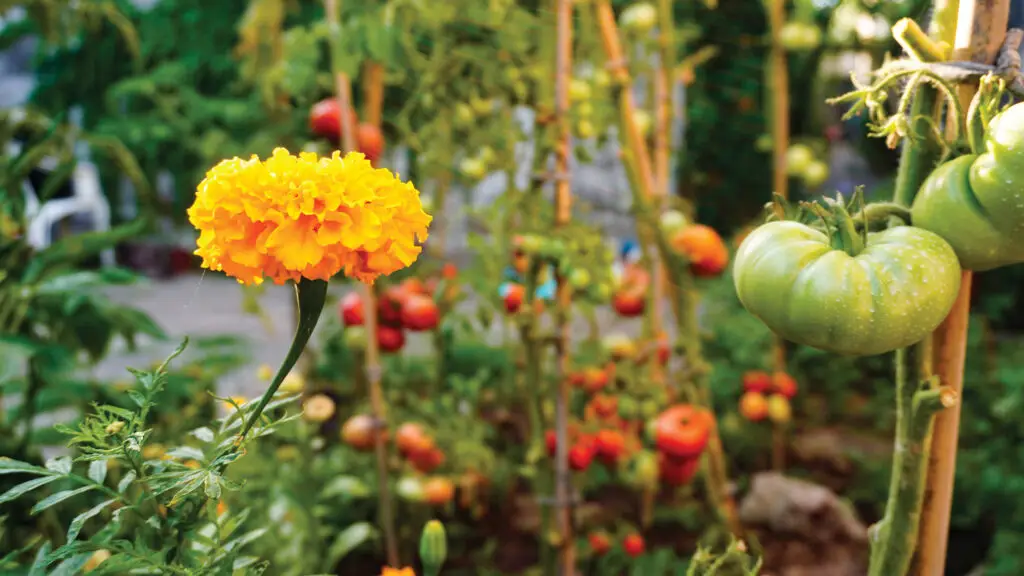Can a single landscape provide a feast for our eyes and for our tables? Yes, it can, if you go “edimental.”

Edimental is the term for garden plants that are both edible and ornamental, plants that look and taste great and are elemental to the increasingly popular gardening practice of “foodscaping.” Also known as edible landscaping, foodscaping mingles edible and ornamental plants together in the same space to create a landscape that is as beautiful as it is functional.
This may seem like a radical idea, especially here in the U.S. where the convention is to use ornamentals in the front yard and relegate food-producing plants to the back, never the twain shall meet. To some degree, that’s an understandable convention. After all, ornamental plants are primarily cultivated for their aesthetic qualities such as foliage, flowers, bark, berries, shapes and fragrances that make them eye candy for the landscape. Food plants, on the other hand, are cultivated to provide bounteous yields of nutritious, delicious produce, but not so much for their looks.
Granted, the two types of plants can have very different cultivation needs and life spans, which is another reason they are often planted apart from one another. But they can also be great partners in the landscape, especially if they have edimental qualities.
And there are lots to choose from. For example, many culinary and medicinal herbs, flowers, vegetables, grains and fruit- and nut-bearing plants are also gorgeous ornamentals. Leafy greens, cabbages, peppers, tomatoes, carrots, artichokes, onions, strawberries and other edible crops look great in borders, ornamental beds and pots. And lots of traditional ornamental plants such as pansies, daylilies, hostas, ferns, roses, lilacs, camellias and hawthorns have edible parts (flowers, leaves, roots, berries and stems).
Combining these plants in a foodscape allows us to grow our own healthful food and possibly lower our grocery bill while also reducing our carbon footprints. That’s because foodscapes tend to be more drought and pest-tolerant and require less inputs of water, fertilizer and pesticides, thus saving money, time and the environment.
In addition, foodscaping is a form of permaculture, a holistic nature-based approach to gardening and farming that helps protect and support the environment and biodiversity. And it can be done anywhere, from apartment patios to large yards to public parks.
The really good news is that you can go “edimental” without ripping out the whole yard. Just add vegetables and herbs to existing areas of the ornamental landscape, such in borders, flower beds and containers. Or start small by replacing a section of lawn with a new in-ground or raised bed filled with edimentals and gradually replacing unwanted ornamental perennials with edimental species.
Whether you want to ease into foodscaping or turn your whole yard into a food forest, it’s a good idea to have a plan. Start by making a list of the plants you want to grow, including which plants will produce foods you like to eat and which ones can provide the ornamental qualities, including things like color and size, you need and want.
Next, assess the site’s growing conditions (sunny or shady, dry or wet, etc.) and soil quality, which will help determine what plants will grow best there and give you a chance to amend and improve the soil before planting. Take a hard look at what’s already growing there, too. You may need to eliminate existing turfgrasses, invasive species or unwanted ornamentals, which could take some time and effort, or there may be plants there you want to keep. Also consider if the location is convenient to access and manage — close enough to a water supply or the kitchen, for example.
To learn more about establishing a foodscape and using edimentals, check out Brie Arthur, a North Carolina-based foodscaping expert and author whose YouTube channel (@BrieThePlantLady) is full of information. Another go-to resource is Edible Landscaping: Now You Can Have Your Gorgeous Garden and Eat It Too! by Rosalind Creasy, one of the founding leaders of the foodscaping movement.




